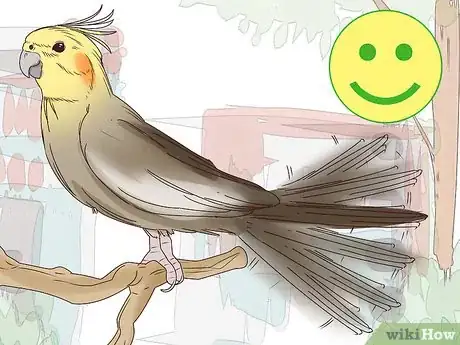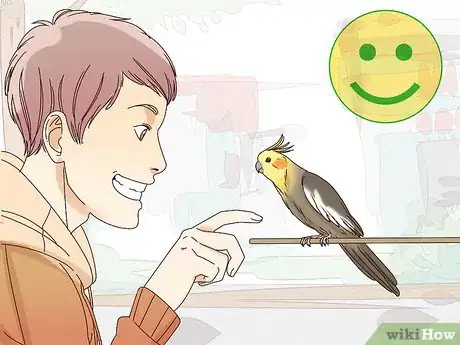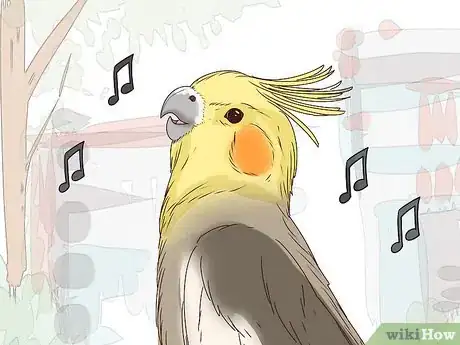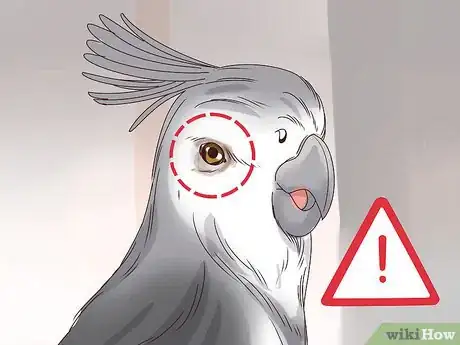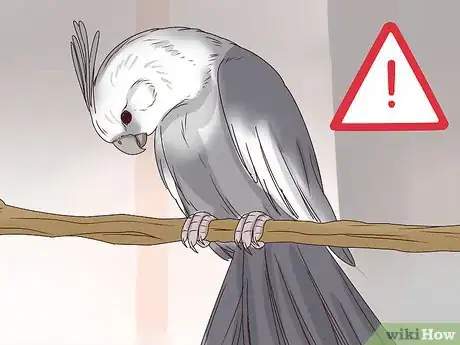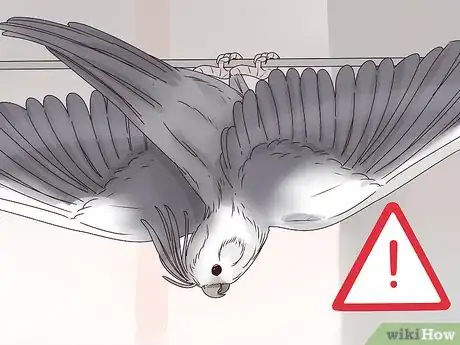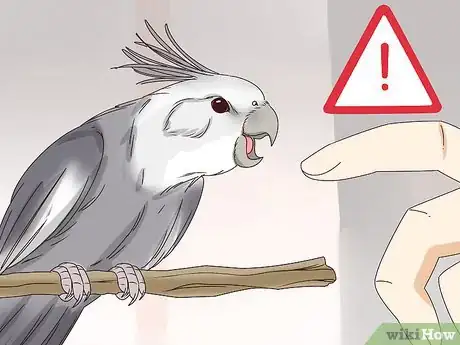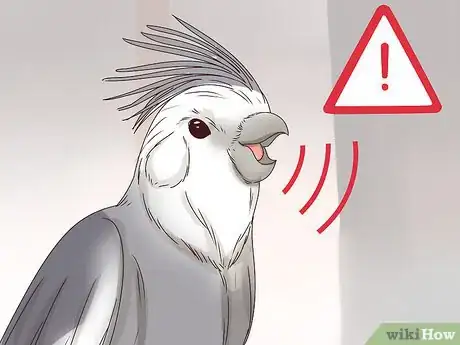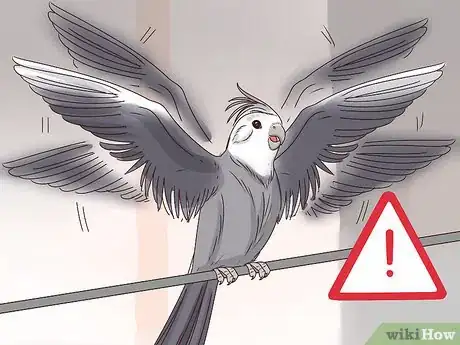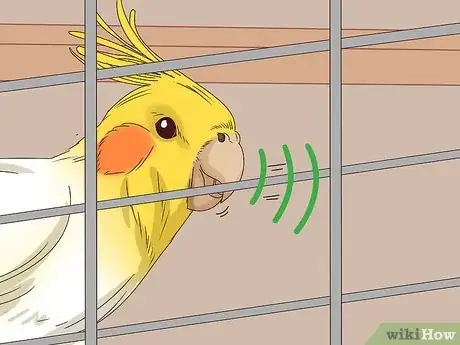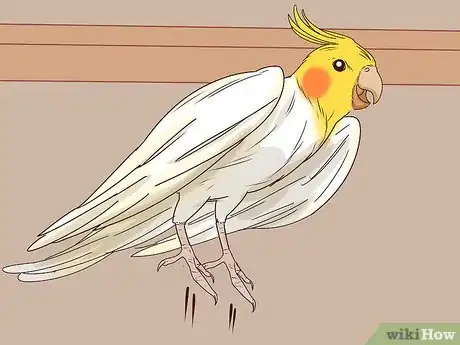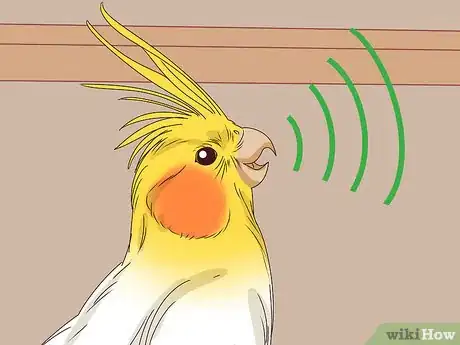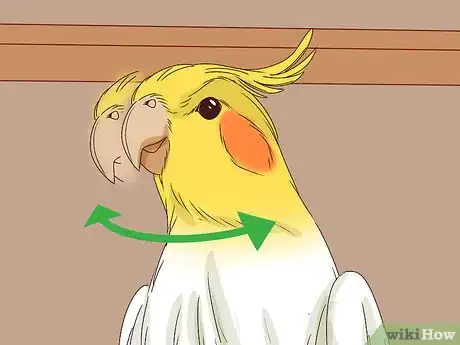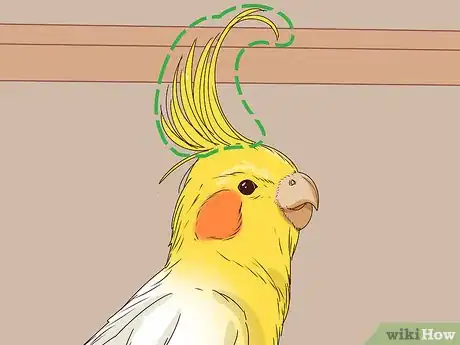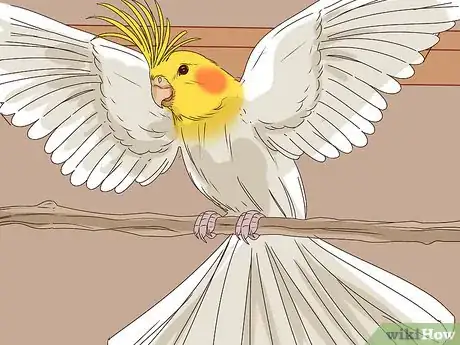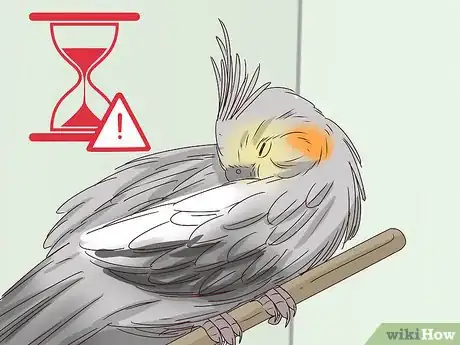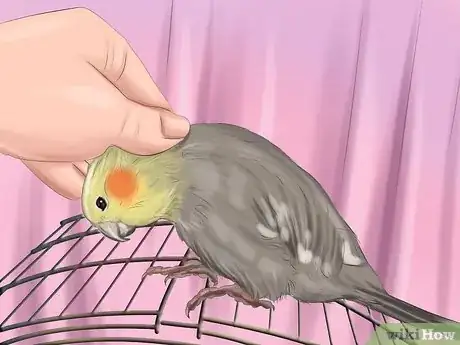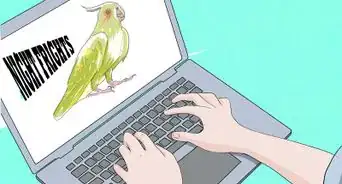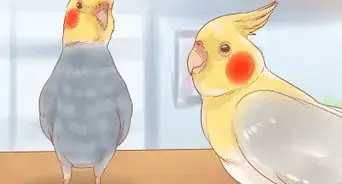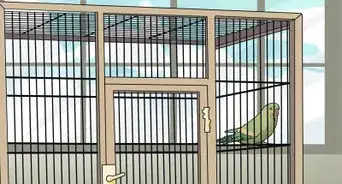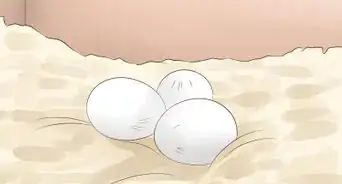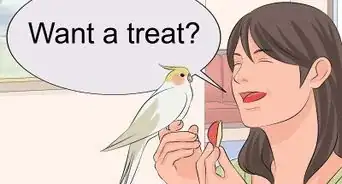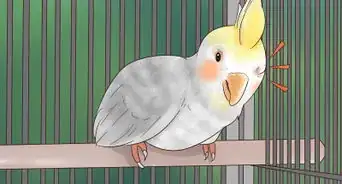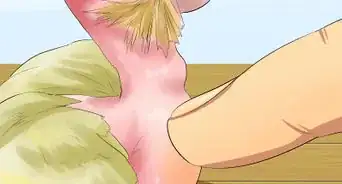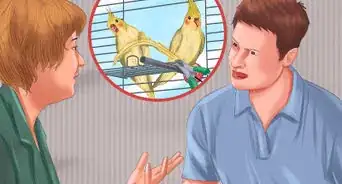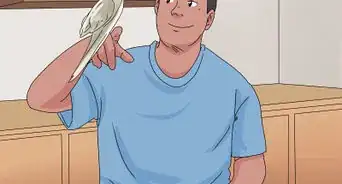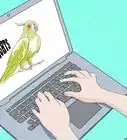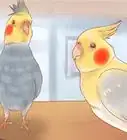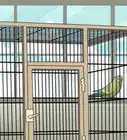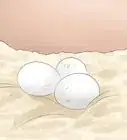This article was co-authored by Hayley Heartfield. Hayley Heartfield is a Bird Specialist and the Owner of About Birds, a Pet Bird Shop in Montgomery County, Texas. Hayley specializes in pet bird care, behavior, training, and breeding. Hayley studied Animal Science at Texas A&M. About Birds carries many species of birds and offers grooming and boarding services as well as bird care products.
There are 11 references cited in this article, which can be found at the bottom of the page.
wikiHow marks an article as reader-approved once it receives enough positive feedback. This article received 25 testimonials and 83% of readers who voted found it helpful, earning it our reader-approved status.
This article has been viewed 496,080 times.
Just like with humans, you can learn a lot about what a cockatiel is thinking and feeling based on their gestures. From the movement of their feathers to the way they shake their head, everything your cockatiel does can give you a glimpse into their secret, mysterious world. Keep reading to learn how to understand cockatiel gestures so you can bond even more with your feathery friend and make sure they're always happy and content.
Steps
Looking for Signs of Contentment
-
1Notice tail wagging. Birds do wag their tails, just like other pets. The bird will wag it back and forth. Generally, this gesture means the bird is happy.[1]
-
2See if he walks toward you. If you're nearby and he comes to you, that's a sign he's happy you're there. However, he's only happy if his head is up as he walks to you, rather than pointing face-down.[2]
- If the bird puts its head down near you, it's probably asking for head scratches.[3]
Advertisement -
3Listen for noise. While generally not a gesture, cockatiels like to talk when they are happy. They will sing to themselves or whistle. They'll also make little chirping noises.[4]
Watching for Signs of Aggression
-
1Pay attention to flashing or dilating pupils. If the cockatiel's eyes suddenly dilate, that could be a sign he's getting mad. Stop what you're doing if you see this warning sign.[5]
-
2
-
3See if he flips upside-down. This stance, paired with spread wings, is usually a sign he's trying to defend his territory. It's probably time to back away if he's making this stance while you're near the cage.[8]
-
4Watch for snapping. Cockatiels will lunge at you if they are about to bite. They may also snap in your direction with their beak. You should leave him alone for a bit if he's trying to snap at you.[9]
-
5Listen for hissing. While hissing is not a gesture, it does go hand-in-hand with other aggressive behavior, such as lunging. If you hear your cockatiel hiss, he may be about to bite.[10]
-
6Notice wing flapping. Wing flapping, when the bird makes an expansive gesture with his wings and moves them up and down, is usually a sign he's mad or annoyed. Try to leave him alone for a bit, if you've been bothering him.[11]
Checking for Attention-Seeking Behaviors
-
1Look for beak banging. Some cockatiels, usually males, will bang their beaks against things, such as counter tops and cages. The idea is to be noticed, usually by whatever or whoever has become their love interest.[12]
- Cockatiels can fall in love with objects, their own reflection, other birds, and even you.
- He may also whistle or lean towards the person or item.[13]
-
2Watch for hopping. Hopping is similar to beak banging; he's looking for attention. However, hopping is taking it to the next level from beak banging. He's really begging for attention.[14]
-
3Listen for loud squawking. Sometimes, in coordination with other behaviors, cockatiels will make loud squawking or screaming noises. Basically, the cockatiel is looking for attention.[15]
-
4
-
5Look for the cresting of the head feathers. When a cockatiel is trying to attract a mate, he may let the feathers on the top of his head curl up into a crest. Basically, it creates a little curlicue on the top of his head.[18]
- However, he could also be defending his territory with this gesture.
-
6Watch the tail and wing feathers. Another sign of seduction is the fanning of the tail feathers, paired with the cresting of the head feathers and the spreading out the wings. He may also strut around and whistle.[19]
- Again, this gesture could also be a sign he's defending his territory. Watch if he hisses. This is usually a sign for you to back off.
Noticing Signs of Sickness
-
1Watch if your cockatiel bobs his tail. Sometimes, when a cockatiel is sick, he will bob his tail. If you notice this sign, it may be time to take him to the vet.[20]
-
2Look for sitting. Another indicator your bird could be sick is that he sits. He'll either hunch down on the perch or sit on the bottom of the cage.[21]
-
3Notice other signs of sickness. While these signs aren't necessarily "gestures," they can also indicate sickness. For instance, your bird may sneeze, get extra sleepy, or lose his voice.[22] He may also may eat more or less, or he may suddenly drink more water. Finally, his droppings may change in appearance (color) or number.[23]
-
4You might also notice behavioral changes in your bird. Feather plucking may be sign of boredom, but is also a symptom of Beak and Feather disease.
- It's important to know what is normal for your bird and what is not. If you notice anything out of the ordinary, contact your vet.[24]
Expert Q&A
-
QuestionWhat are the signs of a sick cockatiel?
 Hayley HeartfieldHayley Heartfield is a Bird Specialist and the Owner of About Birds, a Pet Bird Shop in Montgomery County, Texas. Hayley specializes in pet bird care, behavior, training, and breeding. Hayley studied Animal Science at Texas A&M. About Birds carries many species of birds and offers grooming and boarding services as well as bird care products.
Hayley HeartfieldHayley Heartfield is a Bird Specialist and the Owner of About Birds, a Pet Bird Shop in Montgomery County, Texas. Hayley specializes in pet bird care, behavior, training, and breeding. Hayley studied Animal Science at Texas A&M. About Birds carries many species of birds and offers grooming and boarding services as well as bird care products.
Bird Specialist Every bird is a little different, but generally if your bird is acting lethargic, with its head down and feathers fluffed up, that can be a sign of illness. You should take it to the vet for a check-up.
Every bird is a little different, but generally if your bird is acting lethargic, with its head down and feathers fluffed up, that can be a sign of illness. You should take it to the vet for a check-up. -
QuestionWhat does it mean when a cockatiel bobs his head up and down?
 Pippa Elliott, MRCVSDr. Elliott, BVMS, MRCVS is a veterinarian with over 30 years of experience in veterinary surgery and companion animal practice. She graduated from the University of Glasgow in 1987 with a degree in veterinary medicine and surgery. She has worked at the same animal clinic in her hometown for over 20 years.
Pippa Elliott, MRCVSDr. Elliott, BVMS, MRCVS is a veterinarian with over 30 years of experience in veterinary surgery and companion animal practice. She graduated from the University of Glasgow in 1987 with a degree in veterinary medicine and surgery. She has worked at the same animal clinic in her hometown for over 20 years.
Veterinarian Head bobbing happens as a way of getting your attention. In a very young bird, this might be because he's hungry and wants to be fed. If he is an older bird, he may be showing off and the bird equivalent of saying, "Look at me, I'm beautiful."
Head bobbing happens as a way of getting your attention. In a very young bird, this might be because he's hungry and wants to be fed. If he is an older bird, he may be showing off and the bird equivalent of saying, "Look at me, I'm beautiful." -
QuestionMy new cockatiel is pacing with a raised crest. Does this mean he wants out of the cage?
 Pippa Elliott, MRCVSDr. Elliott, BVMS, MRCVS is a veterinarian with over 30 years of experience in veterinary surgery and companion animal practice. She graduated from the University of Glasgow in 1987 with a degree in veterinary medicine and surgery. She has worked at the same animal clinic in her hometown for over 20 years.
Pippa Elliott, MRCVSDr. Elliott, BVMS, MRCVS is a veterinarian with over 30 years of experience in veterinary surgery and companion animal practice. She graduated from the University of Glasgow in 1987 with a degree in veterinary medicine and surgery. She has worked at the same animal clinic in her hometown for over 20 years.
Veterinarian If your bird is in new surroundings, the clue to his behavior is the raised crest. This is a bird on high alert that is unsure of his surroundings, which fits with him being in a new home.
If your bird is in new surroundings, the clue to his behavior is the raised crest. This is a bird on high alert that is unsure of his surroundings, which fits with him being in a new home.
References
- ↑ http://www.birdsnways.com/wisdom/ww15eii.htm
- ↑ http://www.birdsnways.com/wisdom/ww15eii.htm
- ↑ Hayley Heartfield. Bird Specialist. Expert Interview. 16 August 2021.
- ↑ http://www.birdsnways.com/wisdom/ww15eii.htm
- ↑ http://www.birdsnways.com/wisdom/ww15eii.htm
- ↑ http://www.birdsnways.com/wisdom/ww15eii.htm
- ↑ http://www.birdsnways.com/wisdom/ww15eii.htm
- ↑ https://lafeber.com/pet-birds/cockatiel-behavior-brilliantly-baffling/
- ↑ https://lafeber.com/pet-birds/cockatiel-behavior-brilliantly-baffling/
- ↑ https://lafeber.com/pet-birds/cockatiel-behavior-brilliantly-baffling/
- ↑ http://www.birdsnways.com/wisdom/ww15eii.htm
- ↑ https://lafeber.com/pet-birds/cockatiel-behavior-brilliantly-baffling
- ↑ https://lafeber.com/pet-birds/cockatiel-behavior-brilliantly-baffling/
- ↑ https://lafeber.com/pet-birds/cockatiel-behavior-brilliantly-baffling/
- ↑ http://www.goodbirdinc.com/parrot-profiles-cockatiel.html
- ↑ Hayley Heartfield. Bird Specialist. Expert Interview. 16 August 2021.
- ↑ http://www.birdsnways.com/wisdom/ww15eii.htm
- ↑ http://www.birdsnways.com/wisdom/ww15eii.htm
- ↑ http://www.birdsnways.com/wisdom/ww15eii.htm
- ↑ http://www.cockatiel.com/index-4.html
- ↑ http://www.cockatiel.com/index-4.html
- ↑ Hayley Heartfield. Bird Specialist. Expert Interview. 16 August 2021.
- ↑ http://www.cockatiel.com/index-4.html
- ↑ Hayley Heartfield. Bird Specialist. Expert Interview. 16 August 2021.
About This Article
To understand if your cockatiel is happy, watch for it to wag its tail from side to side. Additionally, you will know your cockatiel is happy if it walks towards you with its head up. alternatively, your cockatiel might be angry if it puts its head down, ruffles its feathers, or flips upside down with its wings stretched out. To find out if it's seeking attention, look for the cockatiel to bang its beak against the cage or counter top. Other attention-seeking behaviors include hopping or moving the head from side to side. To tell if your cockatiel is sick, keep reading!
